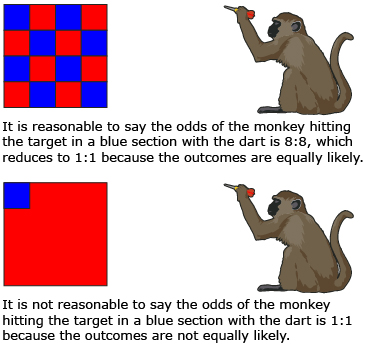Lesson 3
1. Lesson 3
1.3. Explore 2
Module 1: Probability
You should have noticed that when calculating the odds of any player winning the tournament, it was important to know that they were all evenly matched. In the same manner, all ticket holders would be equally likely to win a lottery if they all purchased the same number of tickets.
Self-Check 1
![]()
- Turn to page 168 of the textbook, and work through “Example 1.” Check your answer with the solution provided on the same page.
- Answer “Build Your Skills” questions 1, 2, and 3 on page 172. Answer

In Lesson 2 of this module you learned that to calculate theoretical probability, you need to know the likelihood of each outcome.
In Share 2 you may have noticed that to calculate odds from the number of favourable to unfavourable outcomes, each outcome must also be equally likely.
Probability and odds are closely related in other ways as well. Knowing the number of favourable events and the number of unfavourable events, you can calculate the total number of events that is used in determining probability. The following activity explores how to determine the probability if you know the odds.
Try This 3
In Focus you were told the odds of choosing the six numbers that are drawn in a lottery was 1 to 13 983 815. This means there is one way for you to win and 13 983 815 ways for you to lose.
- What is the total number of events possible?
- What is the probability that you will win?
- What is the probability that you will lose?
- Explain how these probabilities are related to the odds.
![]() Save your work in your course folder.
Save your work in your course folder.